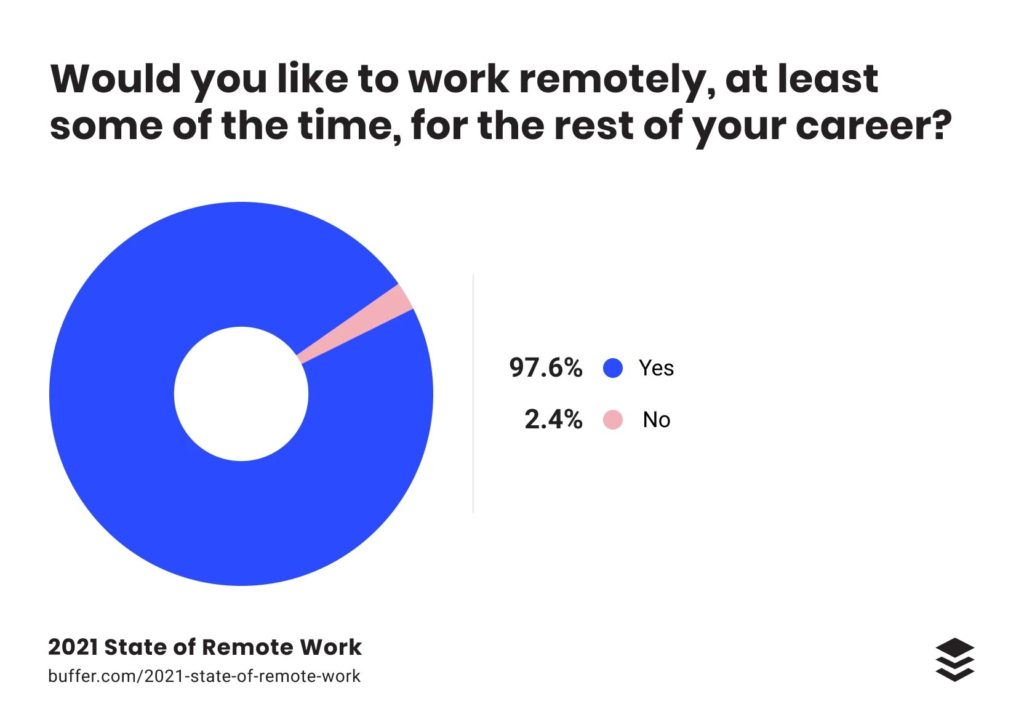These days, many business founders and tech leaders are struggling with the same issue: whether to go with a fully remote team or build a hybrid workplace.
This article will discuss each model’s top pros and cons and determine what tech experts and tech workers prefer. Finally, we’ll give you some tips to make your workspace successful.
The reality of remote work after the pandemic
It’s been two years since the coronavirus pandemic began, so it might be a good time to look at the reality of remote work and hybrid work for tech companies.
If we look at the stats, 97% of people worldwide would recommend remote work to others, and 97.6% would work at least some of the time remotely for the rest of their careers (Buffer). In addition, and according to Own Labs, 1 in 2 people won’t return to jobs that don’t offer remote work after COVID-19.

Source: Buffer
Now that the numbers are more precise, let’s dive into the two main work models that have arisen these days and discover their pros and cons.
Remote-first teams: benefits and challenges
In a remote-first scenario, all employees can work remotely and decide where they want to work – at home, in a co-working space, or in a different country. They can also perfectly work full-time or part-time.
Here, we’d gathered the main benefits of remote work for tech teams:
- Increased productivity
Tech remote employees are generally more productive on remote jobs because they can work when they are the most focused (even if this is after midnight!).
- A large talent pool
Great top tech talents are in high demand. And it is not easy to find the right one if you are looking for a specific tech stack. However, if you open up the option to hire tech talent remotely, you can attract and retain the best of the best talent out there — no matter where.
- Lower costs
Hiring remote tech talents means choosing the place where they prefer to work and using their favorite equipment. Besides, they usually have a reliable internet connection wherever they go. Therefore, you won’t need to set and design a great location to attract them and keep them engaged.
However, there are some challenges of a remote workplace you need to take into consideration:
- Isolation and lack of communication
It can be challenging to stay in contact with your remote team members and build trusting relationships. Besides, there is always a risk of isolation and lack of creativity due to limited opportunities for brainstorming sessions.
- Bad cybersecurity habits
As a full remote tech company, you need to be more careful about cybersecurity. Remote workers may not have the same level of security at home as they would in an office, making it easier for hackers to obtain sensitive information. You will need to train your employees and invest in cybersecurity awareness to counter this.
Hybrid teams: benefits and challenges
Hybrid tech teams are composed of employees that split their time between working at home and in the office. This hybrid work model has become popular in recent years, since more and more companies are looking for ways to improve productivity and reduce costs.
Take a look at the main benefits of hybrid work for tech teams:
- Increased communication and collaboration
Employees can enjoy the flexibility and autonomy of working from home while still collaborating with colleagues in person. They can decide to return to the office if they want to.
- Higher levels of productivity
Your team members have the opportunity to create a work environment that suits their unique needs and preferences. This can lead to higher productivity and satisfaction and increased retention rates.
- Less cost
You don’t need to provide as much office space if some employees work remotely. You can also save on things like utilities and cleaning services.
But pay attention to the challenges of hybrid work you will eventually face:
- Team cohesion
With some employees working remotely and some working in the office, setting up meetings and maintaining communication and collaboration can be challenging. Besides, some of them might feel isolated and disconnected from the rest.
- Office redesign
In a hybrid working arrangement, you will need to plan the office layout carefully, invest in more ergonomic furniture and equipment, and create a more dedicated workspace for meetings and collaboration, which can also be costly.
Why should your tech team go remote
The benefits of hiring remote tech experts are hard to ignore. Alexis Ohanian, who co-founded Reddit in 2005, said: ‘Remote work is the future of work.’ And here, at UPPER, we believe firmly so.
But why should you consider putting your structure to work as a remote team?
You have plenty of reasons:
* It can help to cut costs. No need to rent an office or buy expensive equipment.
You have access to a much wider pool of candidates to scale your team, whether they’re based in another city or country.
* If you use the right tools, you can manage your team just as effectively as a traditional one (or even more).
* It can help to boost productivity and creativity.
* It offers a greater sense of work-life balance and freedom.
* Remote teams are more flexible and agile. They can adapt quickly to changing needs and priorities.
So if you are looking for ways to improve your technology team, going remote is the best option to consider.
5 tips for a great and efficient remote-first tech team
Any business looking to stay ahead of the curve these days needs a remote-first tech team. So, besides our quick steps, we have asked our CTO, Vlad Cazacu, what would be the ultimate tips he would give about managing a tech team in a remote setup:
One of the bigger challenges of managing a fully remote team is building a culture and a feeling of presence and connection within the team and the company overall. This always starts with the manager: you need to be active and engage with everyone in the company, and lead by example to encourage your team to do the same.
In more practical terms, while there isn’t a catch-all solution for this, it can still be tackled from many angles, one of the most obvious beings occasionally getting the team together offline through team off-sites or company-sponsored meetups for those in the same location. There are also quite a few good online options: team events like gaming sessions, preferably with simple games like GeoGuessr, skribbl or Among Us that everyone can play (drinks optional, but encouraged), or using virtual office apps like Gather or even including an Oculus Quest headset in your onboarding package for VR meetups, brainstorming sessions, etc
In addition, here are 5 tips to make your team as successful as possible:
- Communication is key
Make sure everyone on the team knows what’s expected of them and has the tools they need to stay in touch with each other. Asynchronous communication is essential for remote work environments.
- Encourage collaboration
With different time zones and schedules, it’s essential to be flexible and accommodating when it comes to meeting times and deadlines.
- Be flexible
With different time zones and work schedules, a remote-friendly company needs to be flexible and accommodating when it comes to meeting times and deadlines.
- Keep things organized
From project management tools to communication channels, make sure everyone in your team knows where things are and how to find them.
- Create a remote-first culture
Remote work can be isolating at times, so it’s essential to find ways to socialize and build a great company culture. Whether it’s weekly happy hours or monthly company-wide competitions, making sure all your team members enjoy working together will pay off in the long run.
Ready to hire remote? If you are looking to find the right tech freelance for your team, learn more about UPPER and how we can help you.







